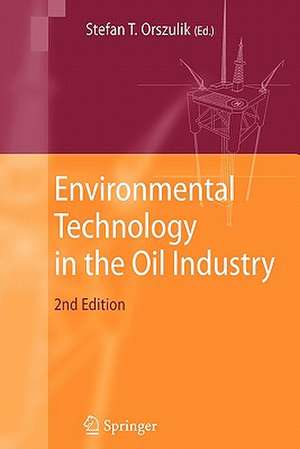Environmental Technology in the Oil Industry
Editat de Stefan T. Orszuliken Limba Engleză Paperback – 19 oct 2010
Preț: 1113.71 lei
Preț vechi: 1358.19 lei
-18% Nou
Puncte Express: 1671
Preț estimativ în valută:
213.13€ • 231.43$ • 179.03£
213.13€ • 231.43$ • 179.03£
Carte tipărită la comandă
Livrare economică 22 aprilie-06 mai
Preluare comenzi: 021 569.72.76
Specificații
ISBN-13: 9789048173761
ISBN-10: 9048173760
Pagini: 420
Ilustrații: XII, 408 p.
Dimensiuni: 155 x 235 x 22 mm
Greutate: 0.59 kg
Ediția:Softcover reprint of hardcover 2nd ed. 2008
Editura: SPRINGER NETHERLANDS
Colecția Springer
Locul publicării:Dordrecht, Netherlands
ISBN-10: 9048173760
Pagini: 420
Ilustrații: XII, 408 p.
Dimensiuni: 155 x 235 x 22 mm
Greutate: 0.59 kg
Ediția:Softcover reprint of hardcover 2nd ed. 2008
Editura: SPRINGER NETHERLANDS
Colecția Springer
Locul publicării:Dordrecht, Netherlands
Public țintă
ResearchCuprins
General Introduction.- Environmental Control Technology for Oilfield Processes.- Environmental Control of Well Integrity.- Environmental Control of Drilling Fluids and Produced Water.- Oilfield Waste Disposal Control.- Drilling and Production Discharges in the Marine Environment.- Decommissioning of Offshore Oil and Gas Installations.- Tanker Design: Recent Developments from an Environmental Perspective.- Pipeline Technology.- Environmental Management and Technology in Oil Refineries.- Distribution, Marketing and Use of Petroleum Fuels.- Lubricants.- Climate Change Scenarios and Their Potential Impact on World Agriculture.
Recenzii
From the reviews of the second edition:
"The book is simply fantastic. It is easy to read and understand with relevant cases and good layout. This book includes everything we needed. It covers a wide range of realistic situations. … it contains relevant information that you can’t find in a lot of books supposedly covering environmental aspects. Written primarily for those working in the oil and related industries, this book also provides essential reference material for government and research institutions and all those with an interest in environmental technological issues." (Current Engineering Practice, 2008)
"The book is simply fantastic. It is easy to read and understand with relevant cases and good layout. This book includes everything we needed. It covers a wide range of realistic situations. … it contains relevant information that you can’t find in a lot of books supposedly covering environmental aspects. Written primarily for those working in the oil and related industries, this book also provides essential reference material for government and research institutions and all those with an interest in environmental technological issues." (Current Engineering Practice, 2008)
Textul de pe ultima copertă
This significantly updated edition looks at each stage in the life cycle of petroleum products, from exploration to end use, examining the environmental pressures on the Oil Industry and its response.
The Oil Industry produces a range of products without which modern civilization could not exist. Nevertheless, in today’s environmentally conscious world, society demands that the industry manufactures and markets the products without unduly polluting the environment. Its ability and willingness to comply determines whether society will allow it a licence to operate.
Technical developments are progressing in line with environmental concerns and increasing sophistication of computer modelling techniques. These subjects are inter-related, but have often been dealt with independently. This book will explore these topics together in a way that will be understandable to the non-expert, and those who are expert in one field, but wish to see their expertise discussed in the overall context.
Written primarily for those working in the Oil and related industries, this book also provides essential reference material for government and research institutions and all those with an interest in environmental technological issues.
The Oil Industry produces a range of products without which modern civilization could not exist. Nevertheless, in today’s environmentally conscious world, society demands that the industry manufactures and markets the products without unduly polluting the environment. Its ability and willingness to comply determines whether society will allow it a licence to operate.
Technical developments are progressing in line with environmental concerns and increasing sophistication of computer modelling techniques. These subjects are inter-related, but have often been dealt with independently. This book will explore these topics together in a way that will be understandable to the non-expert, and those who are expert in one field, but wish to see their expertise discussed in the overall context.
Written primarily for those working in the Oil and related industries, this book also provides essential reference material for government and research institutions and all those with an interest in environmental technological issues.
Caracteristici
Looks at each stage in the life cycle of petroleum products, from exploration to end use Examines the environmental pressures on the Oil Industry and its response Draws together technical developments and environmental issues in a way that will be understandable to the non-expert and expert alike Includes supplementary material: sn.pub/extras
